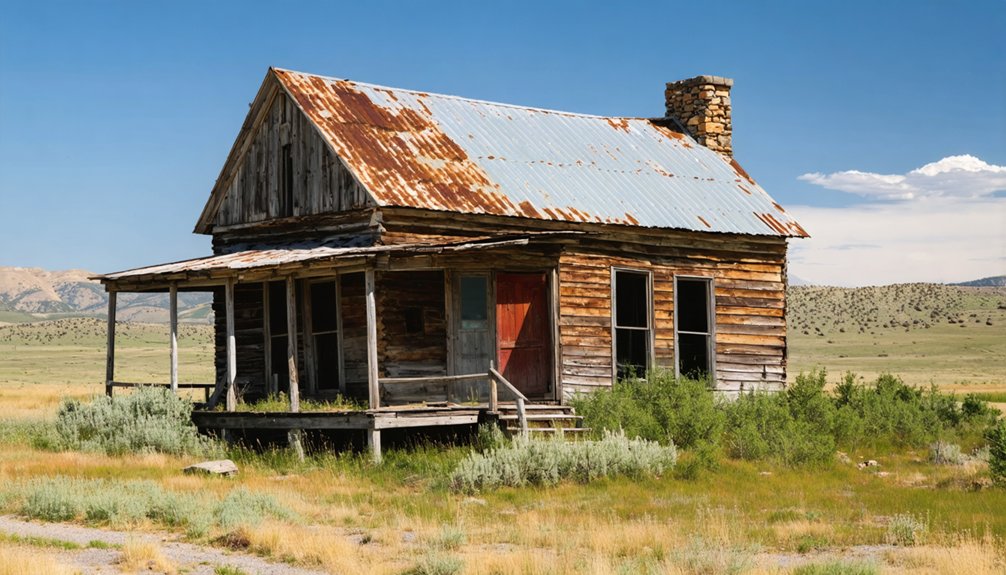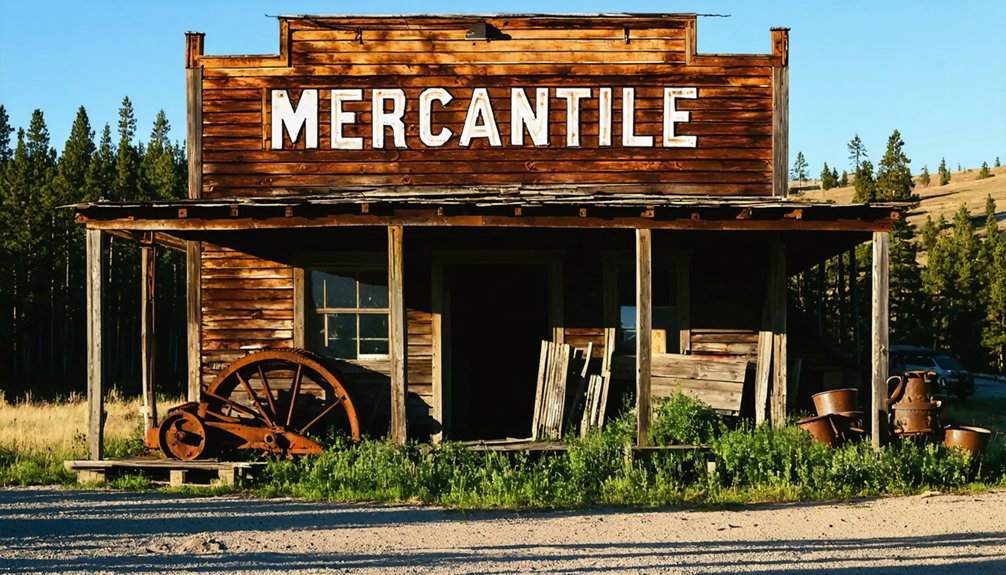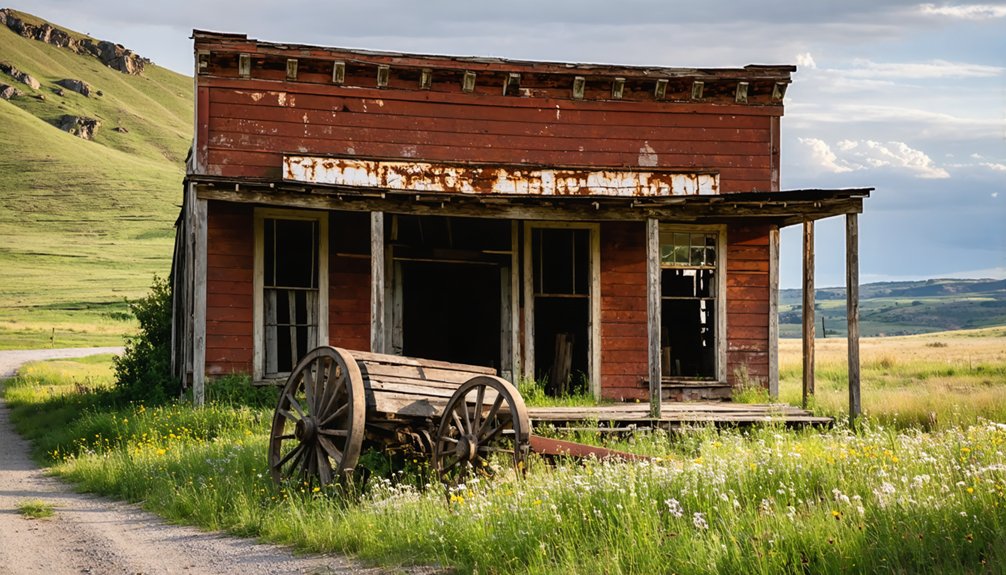You’ll find Rockerville nestled between Rapid City and Mount Rushmore, a former Black Hills mining boomtown established in 1877. Named after the “rockers” used to separate gold from gravel, the town initially yielded $150,000 in its first year of placer mining. After the gold played out, Rockerville reinvented itself as a tourist destination in the 1950s until Highway 16’s rerouting led to its decline. Today, its crumbling structures and mining remnants tell tales of both golden prosperity and ghostly abandonment.
Key Takeaways
- Rockerville, established in 1877 during the Black Hills Gold Rush, is now a ghost town located between Rapid City and Mount Rushmore.
- The town initially thrived from gold mining, producing $500,000 in gold, but declined as placer deposits were depleted by the late 19th century.
- Historic structures including the old jail, livery stable, and blacksmith shop still stand, showcasing typical Old West mining town architecture.
- Tourism briefly revived Rockerville in the 1950s with gift shops and theaters, until Highway 16’s rerouting led to its second decline.
- Today, Rockerville exists as an authentic ghost town at 4,370 feet elevation, featuring crumbling structures and abandoned mining equipment.
The Birth of a Black Hills Mining Camp
When gold was discovered in the Black Hills during the 1870s, Rockerville emerged as one of the region’s promising placer mining camps in 1877.
You’ll find the town’s name came from the “rockers” – devices miners used to separate gold from stream gravel. The discovery sparked rapid development as prospectors rushed to stake their claims in this elevated Black Hills settlement, situated at 4,370 feet in Pennington County.
The camp quickly grew into a recognized town, marked by the establishment of a post office in 1879. The initial success was evident as the area produced an impressive $150,000 in gold during its first year of operations. The success attracted major investors like George Hearst who was actively seeking mining opportunities in the region.
Rockerville’s transformation from mining camp to established town was formalized in 1879 with its official post office designation.
Large-scale operations soon followed as the Black Hills Placer Mining Company introduced advanced hydraulic techniques to extract gold from the rich deposits. They constructed extensive flume systems, including the ambitious 20-mile Rockerville Flume, to power their mining operations.
Gold Rush Glory Days
During its heyday in 1878, Rockerville’s rich placer deposits yielded an impressive $250,000 in gold, outproducing all other Black Hills placer camps combined.
The discovery of gold by Horatio Ross and McKay helped spark the initial rush into the region. You’d have found miners using rocker boxes throughout the camp, a technique so prevalent it gave the town its name. While early placer mining operations struggled with water scarcity, forcing miners to reuse limited water supplies, the construction of a 17-mile flume changed everything. The discovery followed Custer’s 1874 expedition which first revealed gold in the region.
The abundant rainfall of 1878, combined with improved water management systems, released Rockerville’s true potential.
Though some have claimed $20 million in total production, more reliable estimates place the camp’s overall gold yield closer to $500,000.
Despite this more modest figure, Rockerville’s impact on Black Hills mining history remains significant.
Mining Methods and Technology
Mining methods in Rockerville evolved from simple hand-operated rockers to sophisticated crushing and chemical extraction processes.
In early days, you’d find miners using placer mining techniques, working their claims with rockers that separated gold from gravel using limited water supplies. As surface gold depleted, operations shifted to hardrock mining, targeting sulfide ores deep underground.
You’ll see how technology transformed the industry through every stage. Blake crushers and stamp mills replaced manual crushing, while chemical processes like amalgamation and cyanidation improved gold recovery from low-grade ores. The region’s mining innovations continue through multidisciplinary research collaborations at South Dakota Mines.
Mills grew larger, with facilities like the Golden Star operating 200 stamps. The evolution continued with wet and dry crushing methods, each calibrated for specific ore types.
Today, you’ll find South Dakota mines using autonomous equipment and robotics, showing just how far mining technology has come.
Life in Early Rockerville
As the Black Hills Gold Rush gained momentum in 1877, Rockerville rapidly transformed from untamed wilderness into a bustling placer mining settlement.
You’d find settler resilience on display in their mud-chinked cabins and sod houses, built to withstand harsh Dakota weather. Dutch immigrants and other settlers worked together, establishing gardens and stables near water sources while supporting each other through communal support networks. They built their community around the rocky terrain that gave the town its original name.
Life centered around mining activities, with settlers gathering at general stores and business houses to exchange news and supplies.
While miners made up most of the population, the town’s economy expanded to include trading posts and essential services. The community thrived until decreased tourist traffic from Highway 16’s rerouting led to its near abandonment.
You’d see the settlement’s layout naturally following the terrain, with buildings clustered near mining claims and water sources, creating an organic community shaped by both necessity and opportunity.
The Town’s Economic Rise and Fall
You’ll find Rockerville’s early economic trajectory marked by the 1877 gold discovery that transformed this Black Hills settlement into a bustling placer mining camp producing around $500,000 in gold.
While the town thrived initially with multiple businesses serving miners along its main gulch, the limited placer deposits and challenges with dry digging techniques eventually led to its decline by the late 19th century. The area’s mining heritage is now preserved through the historic Rockerville Flume Trail, which showcases remnants of the town’s gold-seeking past.
Tourism attempts couldn’t revive Rockerville’s fortunes, and the town gradually faded into ghost town status as mining activity ceased and residents departed for more prosperous locations.
Mining Prosperity Era
The economic fortunes of Rockerville emerged swiftly after its establishment as a placer gold mining camp in 1877, during the height of the Black Hills Gold Rush. The town’s rich placer deposits quickly attracted miners seeking their fortune, making it one of the most productive mining areas in the region. Similar to the famous Homestake Mine operations, the local mining activities transformed the landscape.
The Black Hills Placer Mining Company revolutionized local mining operations by introducing advanced hydraulic technology, creating an extensive network of flumes that stretched up to 30 miles. Early miners like Spriggs, Lamb, and Dillon demonstrated successful gold panning techniques that helped establish the area’s reputation.
During this prosperous era, you’d have found:
- Elaborate water delivery systems powering hydraulic mining operations
- Bustling supply stores serving the mining community
- Transport facilities supporting the growing settlement
- Various support services catering to the influx of fortune seekers
The boom continued through the 1880s, establishing Rockerville as a significant contributor to the broader Black Hills mining economy.
Tourism’s Failed Revival Attempt
While mining activity faded into history, Rockerville found new economic life as a tourist destination during the 1950s, capitalizing on its strategic location between Rapid City and Mount Rushmore.
You’d have found gift shops, melodrama theaters, and museums lining the main street, all playing up tourist nostalgia with staged shootouts and mining-era relics.
But the town’s dreams of economic sustainability crumbled when Highway 16 was rerouted to bypass Rockerville completely.
Without drive-by traffic, tourist businesses that relied on Mount Rushmore visitors quickly declined.
By the 1990s, theaters went dark, shops closed their doors, and museums shut down.
The town’s failure to diversify its tourist offerings or adapt to changing visitor patterns sealed its fate, transforming this once-bustling tourist stop into a modern ghost town.
From Mining Hub to Tourist Stop
Founded during the Black Hills Gold Rush of 1877, Rockerville rapidly transformed from a bustling placer mining hub into a tourist destination over several decades.
You’ll find that while the town initially thrived on extensive placer gold deposits and hydraulic mining operations, its mining economy declined sharply by the early 1900s as resources depleted.
The town’s cultural significance and location along key Black Hills routes helped shape its second life as a tourist stop.
Despite the absence of modern preservation efforts, Rockerville adapted to serve visitors heading to Mount Rushmore and other attractions.
- Hydraulic mining operations marked some of the first in the Black Hills
- By 1880, the town peaked with hundreds of buildings
- Tourism replaced mining as the primary economic activity after 1915
- Visitor numbers sustained the town through most of the 20th century
Surviving Structures and Landmarks

Several prominent structures still stand in Rockerville, offering visitors a glimpse into its mining town past.
You’ll find the old jail building, livery stable, and blacksmith shop among the most well-preserved historic structures. The tiny schoolhouse remains as a symbol of 19th-century education, while false-front architecture typical of Old West mining towns dominates the streetscape.
Evidence of the area’s mining heritage is visible through remnant ore bins, shaft houses, and the foundations of operations like the Golden Reward Mine.
Historic preservation efforts have maintained a mix of original and reconstructed buildings, including wooden sidewalks that create an authentic ghost town atmosphere.
While many structures show wear from time and weather, they continue to draw history enthusiasts interested in architectural features from both the mining and tourist eras.
Notable Characters and Stories
During Rockerville’s heyday, Captain Jack emerged as one of the town’s most influential early settlers, establishing what became known as Captain Jack’s Dry Diggin’s in 1877.
The town attracted numerous legendary figures and witnessed scandalous events throughout its colorful history.
- Mining claim disputes and rivalries erupted among prospectors fighting over rich placer deposits.
- Corrupt practices involving local officials and mining companies tainted the town’s reputation.
- Failed infrastructure projects and mismanagement led to the community’s eventual downfall.
- Wild West performers and tourist attraction operators brought renewed life in the mid-1900s.
You’ll find that Rockerville’s story mirrors many boom-and-bust mining towns of the era, where dreams of striking it rich gave way to controversy and eventual abandonment.
Legacy in South Dakota History

Beyond its colorful characters and controversies, Rockerville holds a meaningful place in South Dakota’s historical tapestry.
You’ll find its story begins with the 1876 Black Hills Gold Rush, when innovative placer mining techniques and hydraulic operations showcased the community’s resilience in pursuing prosperity.
The town’s evolution mirrors South Dakota’s broader economic transformation. After gold deposits dwindled, Rockerville adapted by embracing tourism, serving travelers en route to Mount Rushmore.
Though it’s now considered a ghost town, its cultural heritage lives on through preserved mining remnants and historical structures.
You can still trace Rockerville’s influence in South Dakota’s mining advancements, and its boom-and-bust narrative continues to educate visitors about the realities of frontier life and western expansion.
Modern-Day Ghost Town Experience
Located along Highway 16 between Rapid City and Mount Rushmore, Rockerville transformed itself from a mining camp into a bustling tourist destination by the 1950s.
Today, you’ll find an authentic ghost town photography paradise at 4,370 feet elevation, where abandoned exploration reveals the raw essence of a bygone era.
Step back in time at this hauntingly beautiful ghost town, where every abandoned corner whispers stories of the past.
The town’s quiet streets offer glimpses into its past through:
- Crumbling historic structures and weathered mining equipment
- Scattered mine tailings and waste piles that tell the story of gold extraction
- Former tourist attractions including empty gift shops and silent melodrama theaters
- Remnants of motels and museums that once welcomed Mount Rushmore visitors
While highway rerouting led to Rockerville’s decline, you can still experience this atmospheric ghost town‘s authentic charm as part of Black Hills tourism routes.
Frequently Asked Questions
Are There Any Documented Paranormal Activities or Ghost Sightings in Rockerville?
You’ll find the Gaslight Saloon’s ghost of Samuelson Harney is the only verified spectral sighting. While ghost hunters report occasional activity in abandoned buildings, there aren’t any other documented paranormal encounters.
What Wildlife Species Can Commonly Be Found Around Rockerville Today?
With 28 raptor species soaring overhead, you’ll spot diverse wildlife sightings around Rockerville, from white-tailed deer and coyotes to American bison, while various bird species inhabit the surrounding Black Hills forests.
Can Visitors Legally Collect Minerals or Artifacts From the Rockerville Area?
You can collect small amounts of minerals using hand tools in Black Hills National Forest, but mineral collection laws require permits for mechanized equipment. Artifact preservation policies strictly prohibit removing historical artifacts.
What Winter Weather Conditions and Temperatures Are Typical in Rockerville?
You’ll face cold days around 30-36°F and nights near zero in Rockerville’s winter climate, with March bringing the heaviest snow of 8-25 inches and Chinook winds occasionally warming things to 60°F.
Are There Any Nearby Camping Facilities or Accommodation Options for Tourists?
You’ll find diverse accommodation options from Rockerville Lodge’s cozy cabins to Pine Haven’s RV sites. You can choose between full-hookup camping facilities, rustic forest campgrounds, and family-friendly lodging near Mount Rushmore.
References
- https://www.sdpb.org/rural-life-and-history/2023-08-21/some-black-hills-ghost-towns-and-their-origins
- https://westernmininghistory.com/towns/south-dakota/rockerville/
- http://www.nebraskaweatherphotos.org/south-dakota-rockerville2006.html
- https://www.youtube.com/watch?v=B_yGTJU5kvU
- https://en.wikipedia.org/wiki/Rockerville
- https://www.blackhillshikingbikingandmore.com/old-mining-ghost-towns
- https://news.sd.gov/news?id=news_kb_article_view&sysparm_article=KB0019676
- https://www.sdhspress.com/journal/south-dakota-history-11-1/booming-the-black-hills/vol-11-no-1-booming-the-black-hills.pdf
- http://www.miningartifacts.org/South-Dakota-Mines.html
- https://www.visitrapidcity.com/the-black-hills-gold-rush-experience/



